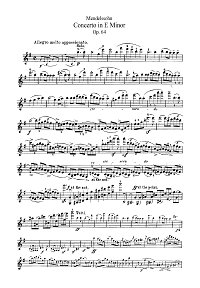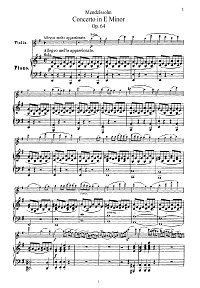Mendelssohn - Violin concerto e-moll Op.64
Mendelssohn - Violin concerto e-moll Op.64. You can download the PDF sheet music Mendelssohn - Violin concerto e-moll Op.64 on this page. Violin Concerto in e Minor, Op. 64 (E moll / mi mineur)
- Allegro molto appassionato
- Andante
- Allegretto non troppo, Allegro molto vivace
Félix Mendelssohn-Bartholdy did not complete his violin concerto in E minor until September 16, 1844, but it had been in his mind for at least six years. During these years he was in regular consultation with Ferdinand David, who was both a great violinist and a great teacher, trying passages over with him again and again in order to perfect them for the instrument. Mendelssohn was on holiday with his family in Soden, near Frankfurt, at the time he completed the concerto. That he was greatly enjoying the informality of life in the country is evidenced by a letter which he wrote to his younger sister in which he says that he is «eating and sleeping, without dress clothes, piano, visiting cards or carriages but with donkeys, wild flowers, music paper, sketchbook, Cécile and the children». This happiness is reflected in the concerto.
To download PDF, click the "Download PDF" button below the appropriate sheet music image.
To view the first page of Mendelssohn - Violin concerto e-moll Op.64 click the music sheet image. |
| PDF format sheet music |
|
|
|
Instrument part: 14 pages. 1067 K
|
Piano part: 28 pages. 2300 K
|
 |
 |
|
|
| Download PDF (14.99
€) |
Download PDF (14.99
€) |
|
The first movement, Allegro molto appassionato, opens with a mere bar and a half for the orchestra and then the soloist enters with the first subject, high on the E string, and earnest it to a passionate climax before handing it over to the orchestra. The second subject is more suave. It is first heard on the clarinets and flutes, the soloist holding a low G through eight bars before taking the theme over for development and embroidery. The cadenza, written by the composer as an integral part of the movement, comes before instead of after the recapitulation, as is more usual, and leads to a beautifully contrived return of the principal subject.
The Allegretto non troppo introduction to the last movement serves as a bridge connecting the second movement to the finale proper and although it occupies no more than fourteen bars, room in found for a formal statement by the solo violin, a reply from the orchestra and an anticipation of the rhythm of the Allegro molto vivace, which, after a tentative trial run or two, so to speak, opens with a joyous and delightfully playful melody for the soloist. The second subject is only a little less exuberant. Soon the soloist suggests a new and more weighty theme and after development and discussion by the orchestra this is played as a counter melody when the first subject makes its final return, enhancing its gaiety and brilliance. |
|